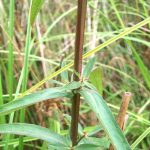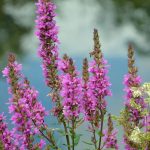Purple Loosestrife
Identification:
A wetland perennial, purple loosestrife can grow from 1.5 feet tall to 10 feet high. The stem of the plant is square and is usually quite hairy. The leaves are opposite or arranged in whorls of three. The purple flowers in whorled clusters bloom from July to September. Purple loosestrife spreads prolifically in open, disturbed sites with moist soil or even in shallow standing fresh water. It also invades undisturbed wetland ecosystems. When purple loosestrife is introduced to a site, it outcompetes and replaces native grasses, cattails, sedges, and other flowering plants that provide a higher quality source of nutrition for wildlife. The highly invasive nature of purple loosestrife allows it to form dense, homogeneous stands that restrict native wetland plant species, including some endangered orchids, as well as reduce habitat for wildlife by eliminating natural foods and cover.
Control:
As of 1997, 3 insect species from Europe have been approved by the U.S. Department of Agriculture for use as biological control agents. These plant-eating insects include a root-mining weevil (Hylobius transversovittatus), and 2 leaf-feeding beetles (Galerucella calmariensis and Galerucella pusilla). These insects are introduced by professionals and are not a management tactic that can be used by homeowners. For small infestations, hand pulling can be effective.



